Choosing the Right Fire Bowl and Fire Pit Table
Despite being in vogue from more than a decade, fire pits have gained immense popularity in the recent past. Homeowners are either upgrading their conventional fireplaces to install enticing copper fire bowl or welcoming their first copper fire pit table home.
What Fire Pit Tables Do?
Besides providing warmth and light after the sun goes down in the evening, fire pit tables and bowls boast many other benefits. A fire bowl spruces up the outdoor space to add ambience and value. It is the ideal space to host family and friends for an enjoyable evening. What’s more, it is also the perfect place for a summer evening barbecue in the outdoor space. The flames of the fire rarely fail to please people and create the ideal environment for a perfect evening. Who does not enjoy sitting and looking at the flames crackling beautifully.
Fire pit tables double up as pieces of furniture that can be used when the fire is not lighted. Add to it colored, rustic, or glass stones to make it more appealing while the fire is burning or even without it.
Finding the Best Fire Bowl or Table
Fire pit tables and bowls are undoubtedly a good investment. However, with the multiple options available, it is overwhelming to decide on the right fire bowl or fire pit table for your outdoor space.
Popular materials used for making fire bowls are concrete, steel, copper, and slick rock. Stylish metal fire pits are a win-win, as they boast durability and elegance. Metal fire pit tables and bowls range from copper and steel to cast iron. However, before you set out to purchase one of them, here’s everything you need to know about metal bowls and tables.
- It is common knowledge that metals heat faster than any other material. Chances of accidents are higher when the fire bowl stands on the ground. It gets heated quickly and could be a threat to the people around. Some fire bowls come with a fire screen that surrounds the flames control the sparks from flying all over the place. A variety of fire bowls are available in the market. Fire bowls standing on a stand of any kind is better.
- It is essential to check with the local codes whether installing a fire pit in the yard is permitted or not. Homeowners keen on installing metal fire pits need to get certain permits and inspection done before installing a metal fire pit.
Fire Bowl Materials
Once this is done, it is time to make a choice from the multiple types of metal fire bowls.
Cast iron is mostly inexpensive. However, as it is a great conductor of heat, it can warm up a big space like a patio efficiently. It is available in different colors, shapes, and sizes. It suffers from the setback of colors fading away due to harsh weather conditions. Colors, however, can be restored with heat-resistant paint. Moreover, they are heavy and can be problematic in bigger sizes.
Steel, on the other hand is lighter in weight and weather resistant. It is expensive when compared to cast iron, but lower in cost against copper.
Copper fire bowl and fire pit tables not only have a traditional rustic appeal, but are highly durable, resist corrosion, and conduct immense heat and radiate it to warm up a decent space. Copper is softer when compared to other metals. Copper fire bowls, are therefore, available in a variety of shapes and sizes like no other metal. The only setback of copper bowls is the weathered patina that develops over time. The good news is that it can be handled with a little elbow grease.
There’s something about the appeal copper exudes. Moreover, it has a conventional and modern appearance that spruces up the outdoor space effectively. So, install copper fire bowls and fire pit tables to bring home ambience, warmth, and light.
For the best variety in fire bowls, contact Outdoor Fire &Patio at www.outdoorfireandpatio.com



Comments
Post a Comment